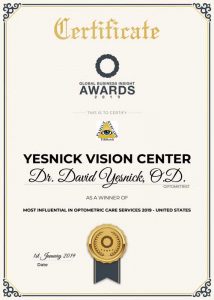Nystagmus is an eye condition that causes involuntary rhythmic eye movements that can be side to side, circular, or up and down. Patients may have trouble focusing and maintaining their balance.
The condition affects 1 out of 1,000 people and there are two main forms. Congenita (infantile) nystagmus appears in the first weeks or months of life, while acquired nystagmus develops later in life. An eye doctor can diagnose the presence of nystagmus and recommend the necessary treatment. Based on the patient’s condition, treatment may include medication, surgery and/or vision therapy.
Nystagmus Symptoms
If you have ever looked out of a window while riding in a fast-moving train and see objects flash by you, you have an inkling of how the world appears to someone with nystagmus. Their eye movements are rhythmic and can’t be controlled, and their eyes may be perceived to be shaking or “dancing.”
These movements cause objects to move in their vision, seem blurry and make focusing difficult. Nystagmus symptoms can be present in both eyes or just one. They can be temporary or in some cases, persist until the underlying cause is treated.
While nystagmus symptoms can vary depending on its underlying cause, most patients have some or all of these symptoms:
- Dizziness
- Blurred vision
- Trouble focusing the eyes
- Poor balance
- Sensitivity to the light
- Continually positioning the head to see better
- Night driving is difficult
The Different Types of Nystagmus
There are several types of nystagmus:
Gaze-evoked nystagmus (GEN)
This common type of nystagmus occurs only when the eyes are not focused straight ahead, but are positioned off-center at either extreme.
Manifest and latent nystagmus
A patient can be said to have manifest nystagmus when symptoms are always present. Latent nystagmus is characterized by shaky eye movements that occur only when one eye is covered. Manifest-latent nystagmus is a combination: the patient has uncontrollable eye movements all the time, but the condition worsens when one eye is covered.
Pendular (optokinetic) nystagmus
When the eyes move back and forth, the patient most likely has pendular (optokinetic) nystagmus. It is usually caused by an eye condition or a problem in the central nervous system.
Jerk (vestibular) nystagmus
This type of nystagmus is referred to as “jerk” (vestibular) nystagmus because the eyes make a jerking motion. They will dart towards one side and slowly drift back to the other side. It is most often caused by a malfunctioning of the vestibular system, which is located inside the inner ear and the brain and interprets information about motion and space.
Congenital (infantile) nystagmus
Congenital (infantile) nystagmus may begin to appear at 6 weeks or 6 months of age. When it is the result of poor vision, it may be called sensory nystagmus. If vision is normal, it is called “motor nystagmus.”
Although the cause of motor nystagmus in children can be uncertain, sensory nystagmus can signal serious problems including:
- Refractive errors
- Congenital cataracts
- Aniridia
- Oculocutaneous albinism
Spasmus nutans
This type of nystagmus is seen in children between the ages of 2 and 8 and is often characterized by head bobbing. It is relatively rare, tends to go away on its own, and is not caused by an underlying problem with the eyes or the nervous system. The causes are often unknown but there has been a suggested link to deficiencies in Vitamin D or iron. In some cases, a brain tumor.
Acquired nystagmus
Head injuries, stroke and neurological conditions like multiple sclerosis can result in acquired nystagmus any time in a person’s life.
How Is Nystagmus Diagnosed?
Diagnosing nystagmus often involves several tests to discover the root cause. These test are given or prescribed by an eye doctor and may include;
- Recording eye movements
- Ear exam
- Neurological exams
- Imaging with CT scans or MRI
You may be asked to spin around for 30 seconds, stop and then focus on an object. If your eyes move in different directions before focusing, you may have nystagmus.
How is Nystagmus Treated?
Treatments for nystagmus will vary according to the cause of the condition. Sometimes, the problem will eventually go away on its own, while in other cases, symptoms must be managed long-term. Your eye doctor may suggest the following:
Glasses or Contact Lenses
Correcting vision can help nystagmus patients see better and manage eye movements. Contact lenses may be the preferred treatment, since the lens rests directly on the eye as it moves.
Medications
The following medications are often used to treat nystagmus:
- Gabapentin (antiseizure)
- Baclofen (muscle relaxant)
- Onabotulinumtoxina (Botox – stops certain extraocular muscles from working to prevent involuntary movement)
Surgery
Surgery is often the last resort and may not cure nystagmus, but can greatly reduce involuntary eye movements. The eye surgeon may reposition certain muscles that control the eyes.
Vision Therapy
Vision therapy is a non-surgical treatment program for a variety of eye conditions, including nystagmus. It is like physical therapy for the eyes and involves special exercises the patient learns at the clinic and then practices at home.
Vision therapy can help patients use both eyes to complete visual tasks, such as focusing the eyes and moving them from one word to the next to read effectively. Patients will also build skills such as tracking moving objects or detecting things in the peripheral vision.
With vision therapy, Nystagmus patients may be able to:
- Focus more clearly
- Slow down eye movement
- Maintain eye contact with someone else
- Read more easily
What Should I Do If I Have Nystagmus Symptoms?
If you notice unusual and involuntary eye movements or blurry vision, schedule an eye exam at Yesnick Vision Center, conveniently located in Las Vegas and Spring Valley.
https://www.allaboutvision.com/conditions/nystagmus-causes/
https://www.allaboutvision.com/conditions/nystagmus.htm
https://www.allaboutvision.com/conditions/nystagmus-symptoms/
https://my.clevelandclinic.org/health/diseases/22064-nystagmus#management-and-treatment

